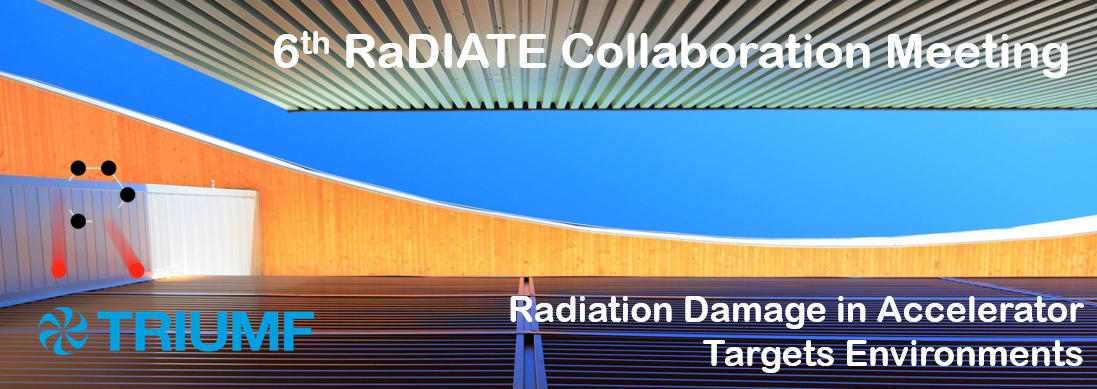Speaker
Mr
Ming Jiang
(University of Bristol)
Description
Abstract
High power particle production targets are key for current and future generation accelerator driven facilities, e.g. neutrino beams such as T2K in Japan and the Long Baseline Neutrino Facility (LBNF) at Fermilab. During operation, the target materials will be bombarded by ultra-high energy protons inducing high thermal stresses and radiation damage, compromising their useful lifetime. Graphite, as a low-Z refractory material, with a low thermal expansion coefficient and low modulus, is uniquely qualified. Several past proton-irradiation experiments carried out at Brookhaven Linear Isotope Producer facility in searching for suitable target material candidates suggested that graphite properties (e.g. elastic modulus, yield strength and coefficient of thermal expansion) degraded with proton irradiation. Due to the important role played by both the initial degree of porosity, crystallinity and the crystalline size in the subsequent development of irradiation damage in graphite (e.g. anisotropic dimensional changes and physical property degradation), it is therefore imperative to obtain a sound understanding of these aspects in unirradiated graphite prior to irradiation experiment [1-5].
In collaboration with U.S. Fermi National Accelerator Laboratory under international RaDIATE programme, this work investigated the microstructures of four grades of unirradiated fine grain graphite target materials over multiple length-scales: POCO ZXF-5Q, IG 430, CL 2020 and SGL R7650, as well as one proton irradiated NT-02 target (POZO ZXF-5Q) extracted from NuMI/MINOS experiment to underpin the selection of next generation proton beam target. Specifically, a multiple length-scale approach incorporating X-ray computed tomography (Zeiss Xradia Versa 520 3D X-Ray Tomography) and Focused Ion Beam serial milling nanotomography (FEI Helios NanoLab 600i Dualbeam) was adopted for the characterisation of porosity. The results showed that the four grades of graphite have distinct porosity structures with the POCO ZXF 5Q graphite having the most uniform porosity size and spatial distribution over the measured length-scales. In addition, the crystal properties, mainly characteristic crystalline size on freshly fractured and machined surface of all four grades of graphite, were studied using Renishaw 2000 micro-Raman spectroscope (514 nm green laser excited from argon filament (Ar+, 2.41 eV excitation energy) at ∼8 mW power). The results showed that machining, either via slow speed diamond saw cutting or electron discharge machining, tends to introduce damage to the graphite surface and results in smaller characteristic crystallite size. The measurements of the ‘true’ crystallite size were therefore undertaken on freshly fractured surface on all samples. It is worth noting that POCO ZXF-5Q has the most narrowly distributed characteristic crystalline size with a mean value of ~80 nm on freshly fractured surface. Further, these Raman spectra data were compared to the results obtained from the proton irradiated NT-02 samples (POCO ZXF grade) at UKAEA Culham (532 nm green laser from argon filament source Raman System (Ar+, 2.33eV excitation energy equivalent) at ∼10 mW power). Irradiation induced disorder, as reflected in the increase in D peak intensity accompanied by G peak broadening, was observed in these irradiated NT-02 samples. The implications of the porosity on the behaviour of irradiated graphite will be discussed and it is suggested that the isotropic properties found in POZO ZXF-5Q could potentially be beneficial to the target performance under applied temperature and irradiation environment.
References
[1]. Krishna R, Wade J, Jones AN, Lasithiotakis M, Mummery PM, Marsden BJ. An understanding of lattice strain, defects and disorder in nuclear graphite. Carbon. 2017; 124:314 – 333
[2]. Kelly B, Burchell T. Structure-related property changes in polycrystalline graphite under neutron irradiation. Carbon. 1994;32(3):499–505.
[3]. Brocklehurst J, Kelly B. The dimensional changes of highly-oriented pyrolytic graphite irradiated with fast neutrons at 430 C and 600 C. Carbon. 1993;31(1):179–183.
[4]. Krishna R, Jones AN, McDermott L, Marsden BJ. Neutron irradiation damage of nuclear graphite studied by high-resolution transmission electron microscopy and Raman spectroscopy. Journal of Nuclear Materials. 2015; 467:557 – 565.
[5] Liu D, Gludovatz B, S Barnard H, Kuball M, Robert O R. Damage tolerance of nuclear graphite at elevated temperatures. Nature Communications. 2017 6;8.
Primary authors
Dr
Dong Liu
(University of Bristol)
Mr
Ming Jiang
(University of Bristol)
Co-authors
Dr
Adel El-Turki
(University of Bristol)
Mr
Georgi Lolov
(Fermilab)
Dr
Kavin Ammigan
(Fermilab)
Mr
Patrick Hurh
(Fermilab)

